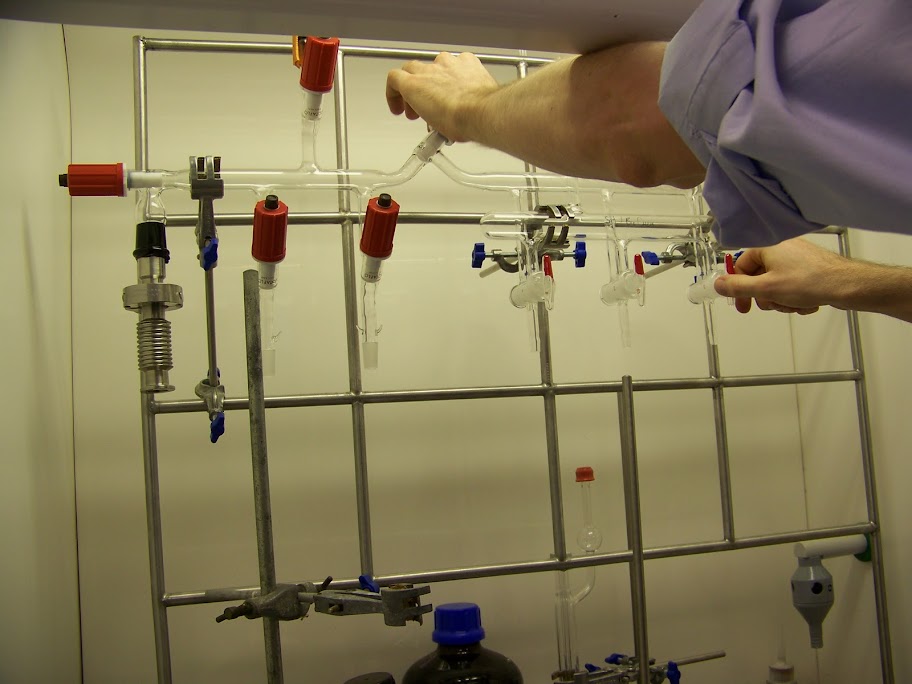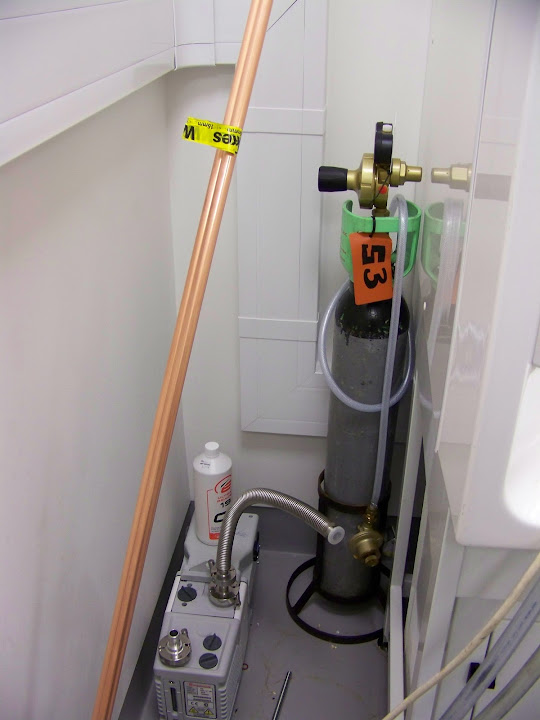I am now the proud owner of a Schlenk line – actually it is not a mere Schlenk line but a hybrid – 1/2 high vacuum line, 1/2 Schlenk. And it is a thing of beauty….
Just look at it

Perhaps I am just super excited because it is my first significant piece of equipment in my new lab but it is also a work of art. It was hand blown by a real human glass blower – who bought some taps and some tubing and made this amazing thing.
The red taps are the high vacuum bit. Once its hooked up to a turbo vacuum pump it is capable of pumping to 10-6 millibar ! Which is a pretty healthy vacuum. Just to put this in perspective…. Atmospheric pressure at sea level (like much of the UK) is about 1 bar, or 1000 millibar (or if you are really picky 1.013 bar or 1013 millibar). So when you evacuate this lovely line with a super pump then there is only 10-6 or 0.000001 millibar (or 0.000000001 bar) of pressure left at the highest vacuum (highest vacuum=lowest pressure) – which is a pretty impressive feat for a bunch of glass and taps if you ask me.

The bit on the right is the Schlenk line bit – its generic name is a gas/vacuum manifold. The amazing thing about this piece of kit is that you can hook up one flask to the line and alternately evacuate it or put it under an inert gas atmosphere (like Argon or Nitrogen (N2)) miraculously being able to handle air and water sensitive compounds in a flask on a bench – how cool is that?
This technique was invented by the German chemist Wilhelm Schlenk . His techniques are still used widely today – largely by inorganic and some organic chemists. Schlenk lines, Schlenk flasks, Schlenk techniques, the Schlenk equilibrium.
I think many people, myself included when I was a graduate student, who use these techniques actually don’t know much about Schlenk’s chemistry but rather about his equipment development. In fact this even inspired Thomas T. Tidwell to write an article about Schlenk in Angewandte Chemie entitled Wilhelm Schlenk: The Man Behind the Flask. Schlenk did some amazing chemistry – he was a synthetic chemist, theoretician and has a pretty wobbly personal story – a meteoric rise in and then subsequent exclusion from science – he’s a man worth reading about.
And lastly but equally important, for this lovely line to work you need a pump and a cylinder of inert gas…


Your post prompted me to Wikipedia, and thence to reading about Schlenk’s more famous student Herman Mark, the father of polymer chemistry.
Mark, who was also the Professor who taught the student Max Perutz physical chemistry, was kicked out of his Professorship in Vienna post-Anschluss for being the son of a Jewish convert to Christianity. Which makes me think… given the times, would I be right in guessing that Schlenk must have objected to the Nazis’ sacking of Jewish scientists after 1933, and was excluded from German science as a result?
Well schlenk definitely kept his morals. I am not sure of all of the details to be honest, I should read more about that..
I’ve now read the article you linked in Angewandte Chemie (hurrah for full-text on-campus access) and that does seem to be the gist of it. Last para of the article:
“[Schlenk] also deserves to be remembered as a man of courage and integrity who dared to risk his high position in opposition to tyranny. He is an example to scientists of all countries that the pursuit of knowledge does not preclude the duty to defend moral principles.”
Schlenk also seems to be one of those scientists who probably ought to have got the Nobel, but for reason of bad luck and timing never did.
Anyway, thanks for drawing our attention to him.
PS Apart from Herman Mark, Schlenk’s other most famous student and co-worker was Ernst Bergmann, later a leading figure in chemistry in Israel.
and thanks for drawing my attention to Schlenk’s famous students – I would have never know about that…
Fabulous thing, Sylvia, and congratulations on the new acquisition. 🙂
It’s oddly comforting to know that such hand- (or would that be “hand to mouth”?) crafting is still the method of choice here. Wonderful. I hope it’s not a dying art.
Where do you attach the kegger?
Does this mean you’re actually doing … experiments?
Shhh don’t tell anyone.. Soon…
That sounds extraordinary. Is the glass tubing pretty thick? And if you gave it a gentle tap when it was under that kind of vacuum would it all implode?
The pressure differential is only 0.1% more than if it had been evacuated to just 1 mbar (the effect of atmospheric pressure variations is much greater), so Sylvia doesn’t have to worry about a gentle tap. Her blog picture doesn’t show if she wears a diamond ring, so she might accidentally scratch it but even then you still need to use a fair amount of force to fracture glass.
Thanks Laurence – well said – those hands in the picture are my post-docs not mine but I would have to knock the hell out of it with my diamond ring to do anything to it – or I could just drop it on the floor, that’d do it
Lacking any form of chemistry degree here I may be wrong, but that rotary pump is not going to reach 10^-6 mbar without some form of diffusion, turbo or drag stage in between the two.
That’s why I say, once it’s hooked up to a turbo …..
I ve to install a schlenck line in my lab. Pl. tell the source.
One of our customers called me for a Schlenk line and I’d heard about it but couldn’t quite remember…. that way I came across this weblog. I really enjoyed reading that there are still people who appreciate the craftmanship of the scientific glassblowers, It made my day!! I hope you made good use of it. About the vacuum and imploding of the glass tubes; those small diameters tube don’t have any problem with high vacuum and since there’s only little volume inside the tube, imploding, what will never happen, wouldn’t be a problem. I know a glassblower that drives a 2 inch nail into a wooden block with a 4 ltr round bottom flask, just to show how strong glass is….